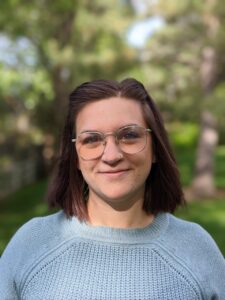JCC Fellow Dr. Hannah Ledvina discovers new molecular mechanism in innate immune response
Dr. Hannah Ledvina – a JCC Fellow in Dr. Aaron Whiteley’s lab at the University of Colorado, Boulder – has discovered a new mechanism for how bacteria fend off infecting phage. All organisms, including bacteria, possess innate immune systems to sense foreign pathogens and to prevent their proliferation. In fact, the bacterial proteins investigated by Dr. Ledvina are the evolutionary predecessors of the human cyclic GMP-AP synthase, or cGAS for short.

New molecular mechanism discovered in innate immunity response
Dr. Ledvina was studying previously uncharacterized proteins involved in the innate immune system of Vibrio cholerae. Intriguingly, Dr. Ledvina found that one of these proteins, termed Cap2, is absolutely required for activating an immune response against phage infection. By solving the structure of Cap2, they found that it resembles both the ubiquitin E1 and E2 enzymes fused together. In the ubiquitination system, E1 and E2 enzymes prime ubiquitin prior to conjugation to target proteins. However Cap2, does not ligate ubiquitin, but rather ligates the cGAS predecessor to target proteins. Activation of the immune system in response to phage infection requires this ligation event.
Ledvina and coauthors identified over twenty proteins that are tagged with the cGAS predecessor. It remains unclear which or how many of these targets must be tagged to mount an effective immune response. However, they suspect that at least some of the specific targets are important, since tagging a random protein with the cGAS predecessor is not sufficient to activate immunity.
Ledvina next discovered that the gene next to Cap2, Cap3, encodes for a protease that reverses this process by cleaving the bond between the cGAS homolog and the target bacterial proteins. Immune activation does not require Cap3. However, Ledvina suspects that the protease is important for preventing spurious immune activation in the absence of infection (autoimmunity). Cap3 is likely also important for eliminating activation after resolution of the infection. Additionally, this protease makes the overall reaction a reversible process, eliminating the need for expressing new cGAS predecessor molecules, and target proteins, before subsequent immune activation events. They found that the protease is extremely specific in its protein recognition cleavage site. Thus, they envision this Cap3 and Cap2 will have applications in biotechnology as a way to rapidly target and modify post translation modifications. Ledvina and Whiteley have a patent pending regarding these biotechnologies.
Lastly, Dr. Ledvina demonstrated that Cap2 and Cap3 are conserved in many different types of bacteria. Thus, they believe that this mechanism of immune activation is a common throughout defense pathways. Ledvina collaborated with Dr. Kevin Corbett’s lab (UC San Diego) on this study. Nature recently published their findings.

Future directions
Currently, Dr. Ledvina is pivoting to ask how many different types of defense mechanisms exist in the bacterial immune system. Most work investigating bacterial innate immunity so far, including her recently-published study, focus on how bacteria defend against phage infection. However, there are a broad range of pathogens and environmental factors that may trigger different immune mechanisms. To conduct a broad search for such mechanisms, Ledvina has developed a new high-throughput platform that leverages wild species of bacteria to identify novel pathways. One such example would be to use this platform to investigate the immune responses activated by antagonistic interactions between different bacterial species. This work marks a transition from her previous investigations, and forms the foundation for her independent lab’s future research.
Dr. Ledvina is very thankful for the support and collaboration that have come from JCC. She considers the JCC Fellowship a “major boost to her career”. Also, JCC funding has been instrumental in allowing Ledvina to develop her independent ideas. Ledvina enjoyed attending the annual symposium last year. She notes that helpful discussions there helped refine her ideas for her independent career. Lastly, Dr. Aaron Whiteley, Ledvina’s postdoctoral advisor, was also a JCC Fellow during his postdoctoral training and it has been fun for them to share that connection.
Dr. Ledvina advises new and aspiring JCC Fellows to be brave and to take on bold and risky projects. Both of Ledvina’s projects required taking a big leap forward, and she is glad she took that risk. Ledvina also advises JCC Fellows to find labs that will support their career goals. In her own experience joining the lab of a new PI has been a great place to do exciting science. Thus, she encourages scientists approaching the postdoctoral stage to consider working with new PIs.